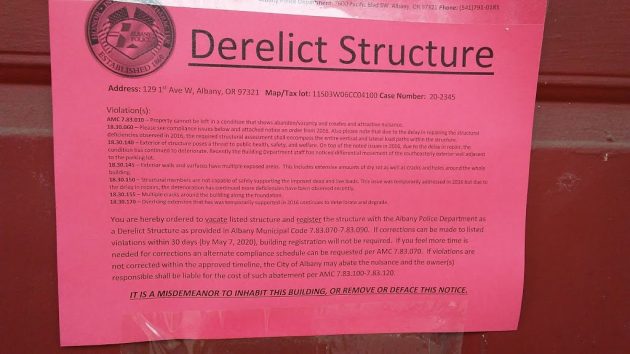
On April 21, I noticed a “Derelict Structure” posting on this century-old building downtown.
In the century since it was built around 1919 or ’20, the structure at 129 W. First Ave. in Albany has been a candy store and various restaurants and bars. Now its long history may be reaching its end. Or not.
The one-story building was the “Espolon” restaurant when it was closed for remodeling in 2016. During that work, in September 2016, part of the front collapsed. The city ordered work stopped, declared the building dangerous and ordered it to be repaired or demolished.
A year later, in November 2017, the owner filed plans to remodel the building based on a handsome design by Varitone Architecture, an Albany firm. In January 2018, the Landmarks Commission approved. But nothing came of it.
In December 2018, the owner of the property, then living in Las Vegas, sold it to the Salem-based Jesus Revival Association for $175,000. According to county assessment records, in the same month the revival group also bought a church building at 1099 Queen Ave. S.W., for $370,000.
Last week I rode by the place on First and noticed a pink posting on the door. It declared the building to be a “derelict structure” and gave the owner until May 7 to respond.
Code Compliance Officer Kris Schendel told me Monday he had posted the notice on April 1 and had not heard from the owner since.

The notice cites a number of structural problems and says they’ve become worse since 2016. Among them: dry rot, cracks around the foundation, and “differential movement” of the wall facing the parking lot.
If the deficiencies are not fixed, the notice says the city may “abate” the situation. Just what that means in this case would have to be decided, Schendel says. If nothing is done, presumably the city could have the structure razed.
You wouldn’t know it from the sorry state of the building now, but it was designed by noted Albany architect Charles Burggraf. Maybe somebody will step up and save the place by dusting off the Varitone remodeling plans and actually carrying them out. (hh)


I know of no reason to “save the place”
If the existing structure can be renovated and repurposed, then it’s worth saving vs. simply demolishing it.
That in a nutshell has always been the issue, the question is: if I get to use your money, is there ANYTHING that I can not do?
So the real question is: Is this place special enough for me to reach in someone elses pocket to get the money to fix it?
Who says anyone is reaching into “someone elses pocket to get the money to fix it?” You know something the rest of us don’t? :-)
Don’t play that game Ray, CARA uses tax money, THAT is somebody elses pocket, I can just see the folks at the theatre coming to CARA to get funds
Yeah Kellum it is important.
Location. Location LOCATION! Right?
What a spot!?!??! Right there. Perfect location.
So much traffic. So many with people with $$$$ in the pocket.
HJ
I agree that it is a great location, which means that there should be PLENTY of money available from business to make this thing work without asking for Public money………………Right?????
No one has asked for CARA support. You crossed that bridge and burnt it behind you before even reaching it…
Yes I did, didn’t I Ray, so when someone walks up to a burned bridge, are they more or less apt to try to cross it/
Still a GREAT spot. Location!
CARA to the rescue. And you hate it. So much HATE. Kellum?
Hopefully, someone will sort this out and a new business can revive the building which would in turn encourage and strengthen the other businesses close by. A derelict building creates problems for neighboring businesses and is an eyesore to the historic downtown. The other option is to tear it down and expand public parking. Doing something is going to be better than doing nothing.
the method to sort this out is called cost v benefit analysis. If public money is used to
pay the cost and the benefit is hyped because special interests “just love old stuff” then the decision should always be to demolish
The structure in question was subdivided decades ago. The western 2/3rds of the building are currently the subject of this action. The eastern 1/3rd of the building is structurally sound and home to the scene shop, dressing rooms, makeup room, office, props storage room and other spaces that are of vital importance to Albany Civic Theater. The theater has been an excellent steward of this section of the building as well as the adjacent, slightly older, building that houses our lobby and auditorium. As a non-profit arts organization that has been in operation for 69 years in downtown Albany we are strongly in support of the current owners, or some future owners, working out a plan with the city to repair the building. It is not difficult to surmise that it would be much more cost effective to repair that front wall than to try to demolish 2/3rds of a building without affecting our 1/3rd. Dean Keeling, President, Albany Civic Theater
What does the Civic Theater pay in rent?
why do you care to ………..ask?
Because I’m trying to figure out the economics of the building otherwise it is a goner!
The theater owns that 1/3rd portion of the structure and the adjacent auditorium building outright. There is no rent.
Just a side note: Both the Albany Civic (Rialto) Theatre And the building in question were designed and built by Charles Burgraff. The ACT building c1898 being the first that he did in Albany, and the other being his last c1919? Pretty special bookends to a long and prolific career. Burgraff died in 1942 and is buried in Salem.